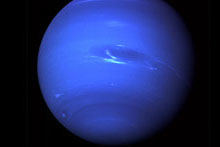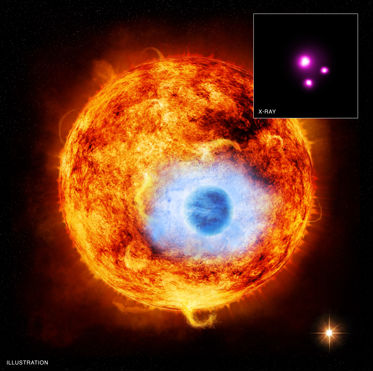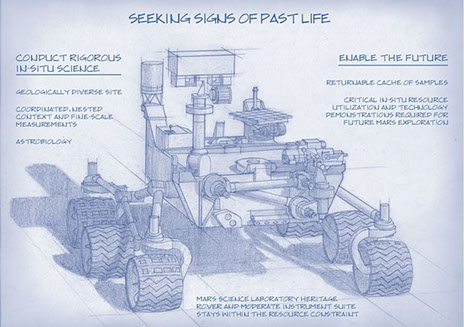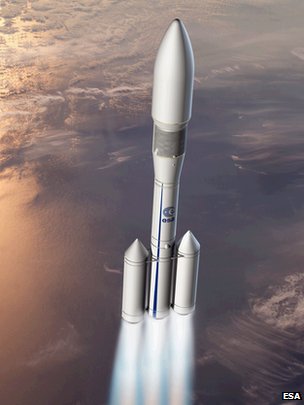



August 2013
Neptune
The Hubble Space Telescope has discovered a new moon orbiting Neptune. This brings the total to 14 known moons orbiting the planet. The moon is 20 km (12 miles) across and makes a complete orbit of Neptune every 23 hours. It is the smallest of all Neptune's known moons. It is so small that the Voyager spacecraft missed it when it passed Neptune in 1989.
The moon is about 100 million times dimmer than the faintest star visible with the naked eye and was tracked as a small white fleck appearing in over 150 photographs take of Neptune by Hubble between 2004 and 2009.
Chandra
NASA’s Chandra X-Ray Observatory has observed an exoplanet passing in front of its parent star for the first time in X-ray. Previously only optical light transits have been observed. Comparing data from optical light and this data from X-Rays, astronomers can learn more of the planet's atmosphere.
The planet is HD 189733b, which is similar in size to Jupiter, but 30 times closer to its sun than the earth is to ours. It is located 63 light-years from earth.
Astronomers have learned that the planet's atmosphere is blue in color due to preferential scatter of blue light by silicate particles. The planet's outer atmosphere is also transparent to optical light but opaque to X-rays. The planet is also losing its atmosphere at rate of about 100 million to 600 million kilograms of mass per second.
Chandra also studied the main star, HD 189733, and discovered it has a faint red companion star. The two stars are believed to have formed together but the main star rotates faster and displays higher levels of magnetic activity. This makes the main star behave younger than the companion star, which scientists think this is due to the planet. The planet is so big and close that tidal forces could explain the star's "young" behavior.
Visit our sponsors.
NASA
For advertising opportunities on this page and our videos, contact
Upcoming Launches
Date: August 3
Launch Vehicle: ISS HTV-4
Launch Site: Tanegashima Space Center, Japan
Description: HTV-4 will carry supplies, hardware, fuel and water to the International Space Station.
Archived Issues


Image Credit: X-ray: NASA/CXC/SAO/K.Poppenhaeger et al; Illustration: NASA
Titan
Cassini has confirmed that Polycyclic Aromatic Hydrocarbons (PAHs) are in the upper atmosphere of Saturn's moon Titan. These PAHs form high up in Titan's atmosphere and fall to the surface much like snow flakes. This then creates the aerosol particles found in the lowest haze later that blankets Titan's surface.
Titan's atmosphere is mostly composed of molecular nitrogen, much like Earth. But unlike Earth, Titan only has traces of oxygen and water. Instead, methane is found in the atmosphere of Titan. This may resemble early Earth, before the rise of living organisms that started putting oxygen into the atmosphere.
The process on Titan is caused by sunlight and highly energetic particles from Saturn's magnetosphere that hit the upper layers of Titan's atmosphere. The nitrogen and methane molecules are broken up and trigger a chain of chemical reactions that produce hydrocarbons, including the PEHs. From there, carbon-based aerosols are formed in the lower atmosphere as the PEHs fall toward the surface.
Mars
NASA unveiled the plans for its next Mars rover. The robot will be a near copy of Curiosity in order to keep costs lower. It will, however, carry some different instruments. The new rover will land in an area that would be a good candidate for once having life and will have new instruments on board that would carry out a search for that early life.
The robot will be capable of visual, chemical and mineralogical analysis down to the microscopic scale.
Scientists are also planning on having a sample collection capability so that future missions by man could retrieve the samples for return to the Earth. Precisely how or when the samples would be returned is unknown but it is hoped it can be achieved in the 2020's or 2030's.
Launch of this new vehicle is hoped to be in 2020.

IRIS
IRIS opened its eyes for the first time on July 17th. IRIS (Interface Region Imaging Spectrograph) is NASA's latest orbiting observatory of the sun. It is designed to study the lower levels of the sun's atmosphere in unprecedented detail. Right from the first photos, scientists saw things they had never seen before, thin fibril-like structures. The images can provide clues to how energy is transported and absorbed in this region.
The lower levels of the atmosphere power the upper, which drives the solar wind affecting Earth and our climate. Satellites, the power grids, and GPS are also all affected by solar activity. Scientists hope IRIS can help unlock many of the mysteries of the sun's workings to help them better protect the Earth and our equipment.
Van Allen Belts
NASA's twin Van Allen Probes have discovered a particle accelerator at the heart of the Van Allen radiation belts. Scientists knew that something in space was accelerating particles in the radiation belts to more than 99 percent of the speed of light. New results from the Van Allen Probes show that the energy comes from within the belts themselves. Particles inside the belts are sped up by jolts of local energy pushing them to even faster speeds. The effect can be related to how hurricanes grow out of a local area of warm ocean water, picking up more and more energy and speed.
The source is a region of intense electromagnetic waves. Understanding the dynamics of the belts can help scientists predict space weather better which can be used to help protect vulnerable satellites. Many satellites, including GPS, have to be positioned between the belts and are thus at greatest risk from increases in radiation.
Ariane 6
ESA has selected the next generation of Europe's Ariane rocket. It will be powered by two solid fuel lower stages and incorporate the liquid fuel upper stage currently being developed as an upgrade for the existing Ariane 5.
The first stage will have three motors to lift the vehicle off the pad. The motors will burn for a few minutes before separating and falling away. A second solid stage booster will then ignite to carry the vehicle into space. Once spent, that booster will be expended and the liquid fuel Vinci upper-stage will fire and carry the satellite to orbit. Vinci will then bring itself out of the sky after the mission to limit the amount of space junk circling the earth.
Ariane 6 will have less lift capability than Ariane 5 but will carry just one spacecraft at a time as opposed to two that Ariane 5 now carries. This configuration reduces manufacture and operating costs. Ariane 6 is scheduled for service in the next decade and will launch from Kourou spaceport in French Guiana.
© 2014-2016 Ted Cook Productions LLC. - All Rights Reserved